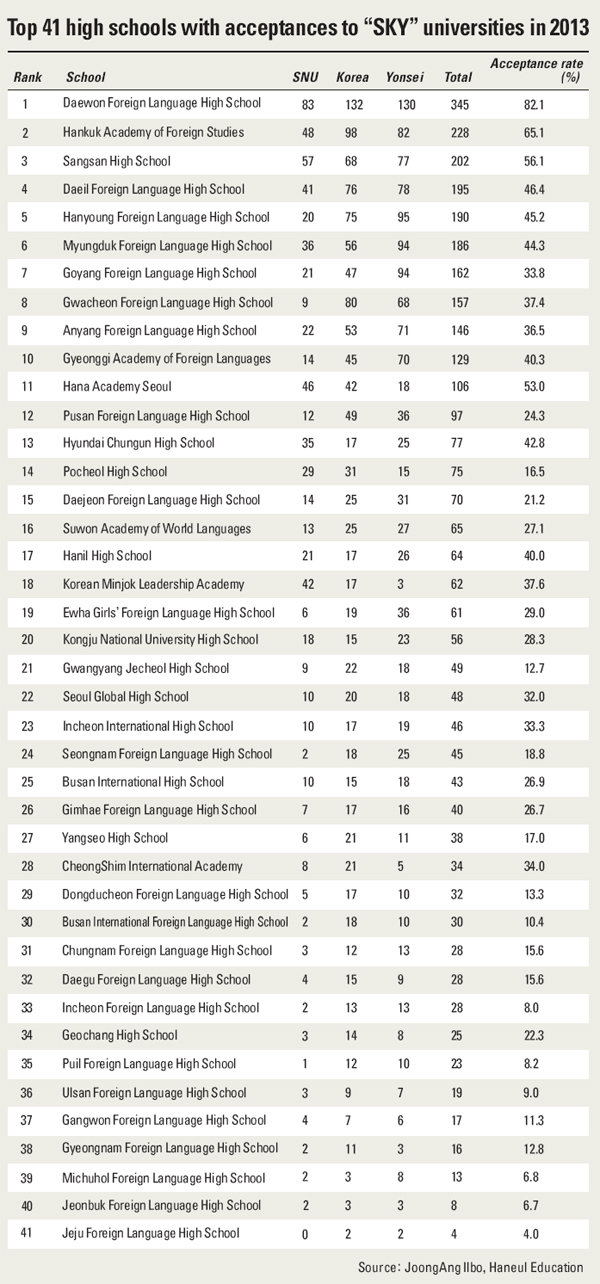‘SKY’ numbers down for elite high schools

But overall, there was a decline in these elite foreign language schools, or special purpose private high schools, garnering acceptances to the coveted “SKY” universities — Seoul National, Korea and Yonsei — this year, especially those outside of Seoul.
For the seventh consecutive year, the JoongAng Ilbo surveyed and analyzed the trend of high schools that matriculated the highest number of students in the “SKY” universities.
With Haneul Education, a college entrance specialist company, the JoongAng Ilbo conducted a joint survey of 41 foreign language, international, private and autonomous high schools to garner highest acceptances.
Daewon Foreign Language High School in Seoul again topped the list with 345 acceptances to the three schools, the highest since 2008 when they sent 348 students.
Eight out of 10 Daewon students were accepted to SKY schools, the highest ratio in the nation. Daewon had 83 acceptances to Seoul National University, 132 to Korea and 130 to Yonsei.
This is, however, down from Daewon’s 92.4 percent record in 2007, with 388 accepted to SKY schools. This has steadily decreased each year and last year 251 students, or 59.8 percent, were accepted into the top three universities.
Hankuk Academy of Foreign Studies in Yongin, Gyeonggi, came in second with 228, or 65 percent, going to SKY schools.
Sangsan High School in Jeonju was third with 202, or 56 percent, of its students accepted into SKY schools.
These three schools were able to stay in the “SKY 200 Club” — schools that dispatched more than 200 students to the top three universities.
Hana Academy Seoul, while coming in eleventh place with 106 students accepted into SKY schools, had 53 percent of its students accepted in its first set of graduates.
These four schools were the only ones that managed to have more than half of their graduates accepted to the top three schools.
Acceptance rate to the SKY schools this year for foreign language schools was 30.9 percent, while international schools was 31.2 percent, autonomous private high schools 32.7 percent and 24.6 percent for independent schools.
Since 2011, the acceptance rates for foreign language schools nationwide into the SKY schools have decreased over the past three years.
The survey included 27 foreign language schools, four international schools, six autonomous private schools and four semi-autonomous schools.
Foreign language schools in 2011 saw 34 percent of students accepted into SKY schools. In contrast, international schools went up this year compared to 25.6 percent in 2011.
Likewise, nationwide autonomous private schools went up from 29.9 percent three years ago.
The foreign language schools that were impacted most were those outside of Seoul.
Of eight foreign language schools in Gyeonggi, the acceptance rate dropped by 3 percent to 35.8 percent compared to 38.9 percent last year.
Goyang Foreign Language High School saw a 61-student decrease from last year though it still came in seventh place, managing to have 162 acceptances this year with a third of its senior student body accepted into a SKY university.
Gyeonggi Academy of Foreign Languages also saw a 25 student, or 16 percent, decline from 2012.
In contrast, second place Hankuk Academy of Foreign Studies, an autonomous private school in 2011, saw a 25 student increase compared to the previous year.
The Lee Myung-bak administration had tried to suppress special-purpose schools such as foreign language schools as part of its education policies.
Instead, the Lee administration from 2009 began its policy to open “100 autonomous high schools,” which are outside the lottery system that assigns most students to schools and can choose students on their own admission standards and can tailor a student’s studies to his or her ability.
Autonomous private high schools are independent of government support and include such schools as Sangsan High, Hana Academy, Hyundai Chungun High School and Minjok Leadership Academy. The idea was to give students and schools more freedom and independence.
Semi-autonomous schools are mostly outside of Seoul and have freedom over hiring teachers and curriculum but receive partial support from the government, such as the four included in the survey: Hanil High School, Kongju National University High School, Yangseo High School and Geochang High School.
Foreign language schools outside of the Seoul and Gyeonggi overall saw a slight decrease in acceptances to the top schools from 14 percent to 13.8 percent. Incheon Foreign Language School saw a drastic drop from 45 students last year to 28 this year.
But foreign language schools based in Seoul on the other hand saw a boost in acceptances from 45.4 percent last year to 51.7 percent this year.
Acceptances in these five foreign language schools in Seoul had declined over the past five years following a peak at 66.4 percent in 2007 and reaching 52.5 percent in 2008.
While the popularity of foreign languages has dropped, this has led to the polarization of Seoul versus non-Seoul schools.
By Sung Shi-yoon, Yoon Seok-man [sarahkim@joongang.co.kr]










with the Korea JoongAng Daily
To write comments, please log in to one of the accounts.
Standards Board Policy (0/250자)